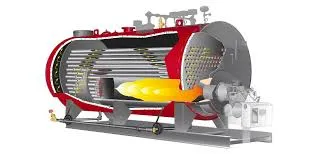
Feb . 20, 2025 08:37 Back to list
biomass fired steam boiler
Determining the appropriate size for a steam boiler is a crucial decision for ensuring not only the operational efficiency of a heating system but also its safety and cost-effectiveness. The intricacies involved in steam boiler sizing can often be nuanced and complex—a reason why seeking expertise is paramount.
High-quality steam generation also intersects with safety standards and regulations, an area where authority and compliance are non-negotiable. Legal mandates necessitate adherence to established standards such as ASME (American Society of Mechanical Engineers) codes or local jurisdictional requirements, ensuring all installed units meet specified safety and environmental standards. Knowledge of these regulations is often the domain of a specialized compliance officer or engineering consultant. Trust in the integrity and reliability of a steam boiler is non-negotiable, hence why the reputation of manufacturers and the robustness of service agreements must be considered. Leading manufacturers with unquestionable authority and reliability, evidenced through warranties and service history, mitigate potential risks of mechanical failures. Ultimately, the decision hinges on integrating these multifaceted considerations thermal requirements, efficiency, structural constraints, regulatory compliance, and manufacturer reliability. The synthesis of these factors demands not just technical know-how but also strategic forethought and an authoritative grasp of the evolving landscape of steam boiler innovations. For businesses investing in steam boilers, the emphasis should always rest on a methodology that combines empirical data and industry-recognized best practices, ensuring an optimal intersection of functionality, durability, and efficiency. This approach not only satisfies the complex demands of steam generation but also future-proofs investments against the inexorable march of technological advancement. In conclusion, wisely navigating steam boiler sizing transcends mere calculations. It embodies an experience entrenched in industrial knowledge, a trust in seasoned expertise, and a commitment to authoritative standards that collectively inform a responsible and foresighted investment.


High-quality steam generation also intersects with safety standards and regulations, an area where authority and compliance are non-negotiable. Legal mandates necessitate adherence to established standards such as ASME (American Society of Mechanical Engineers) codes or local jurisdictional requirements, ensuring all installed units meet specified safety and environmental standards. Knowledge of these regulations is often the domain of a specialized compliance officer or engineering consultant. Trust in the integrity and reliability of a steam boiler is non-negotiable, hence why the reputation of manufacturers and the robustness of service agreements must be considered. Leading manufacturers with unquestionable authority and reliability, evidenced through warranties and service history, mitigate potential risks of mechanical failures. Ultimately, the decision hinges on integrating these multifaceted considerations thermal requirements, efficiency, structural constraints, regulatory compliance, and manufacturer reliability. The synthesis of these factors demands not just technical know-how but also strategic forethought and an authoritative grasp of the evolving landscape of steam boiler innovations. For businesses investing in steam boilers, the emphasis should always rest on a methodology that combines empirical data and industry-recognized best practices, ensuring an optimal intersection of functionality, durability, and efficiency. This approach not only satisfies the complex demands of steam generation but also future-proofs investments against the inexorable march of technological advancement. In conclusion, wisely navigating steam boiler sizing transcends mere calculations. It embodies an experience entrenched in industrial knowledge, a trust in seasoned expertise, and a commitment to authoritative standards that collectively inform a responsible and foresighted investment.
Share
Latest News
-
High-Efficiency Gas Thermal Oil Boilers | HPT Models
NewsJul.31,2025
-
Oil Fired Hot Water Boilers Sale - High Efficiency & Affordable
NewsJul.31,2025
-
High-Efficiency Commercial Oil Fired Steam Boiler for Industry
NewsJul.30,2025
-
High-Efficiency Biomass Fired Thermal Oil Boiler Solutions
NewsJul.30,2025
-
High Efficiency Gas Fired Thermal Oil Boiler for Industrial Heating
NewsJul.29,2025
-
High-Efficiency Gas Fired Hot Water Boiler for Sale – Reliable & Affordable
NewsJul.29,2025
Related PRODUCTS
Copyright © 2025 HEBEI HONGZE BOILER MANUFACTURING CO., LTD. All Rights Reserved. Sitemap | Privacy Policy






















